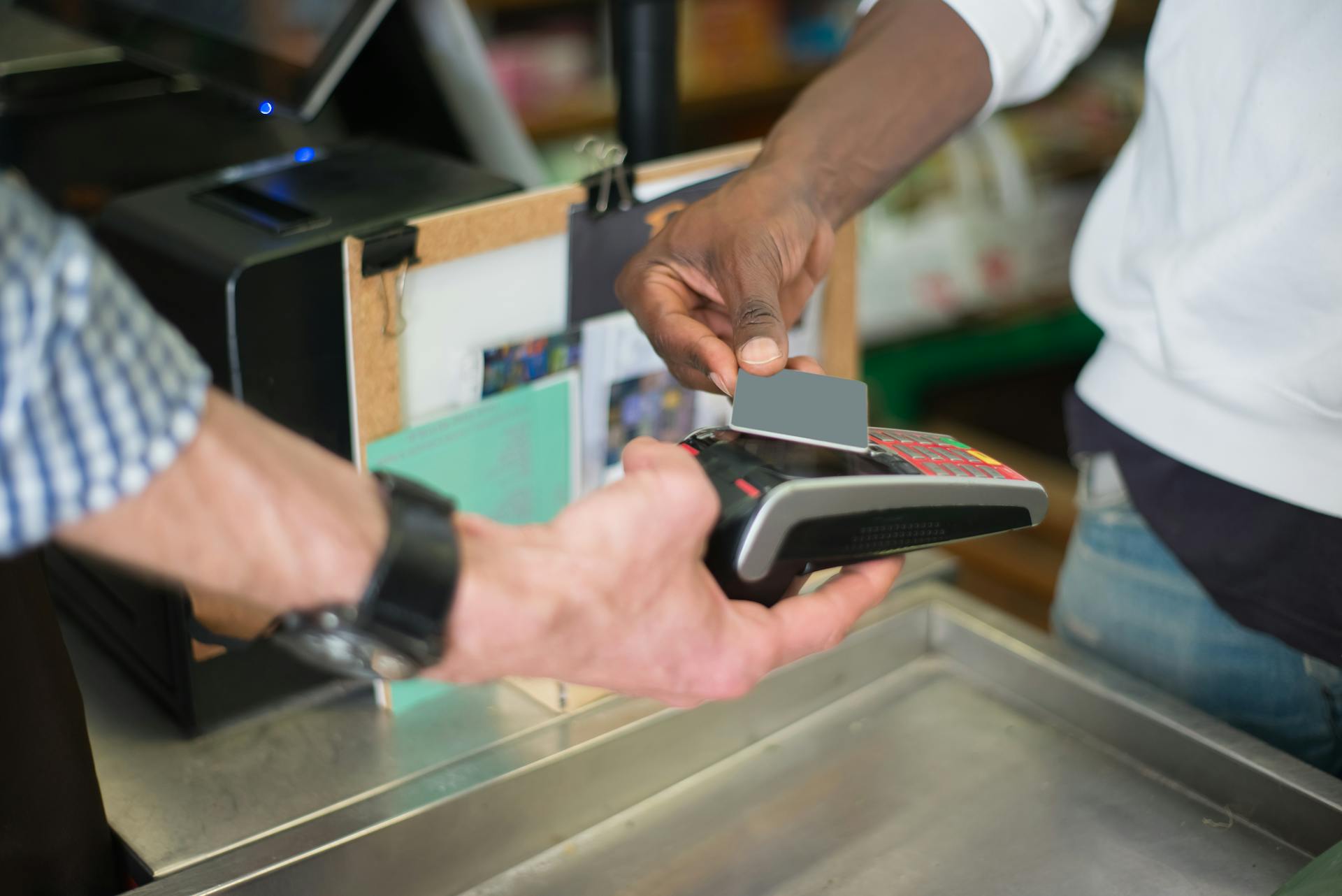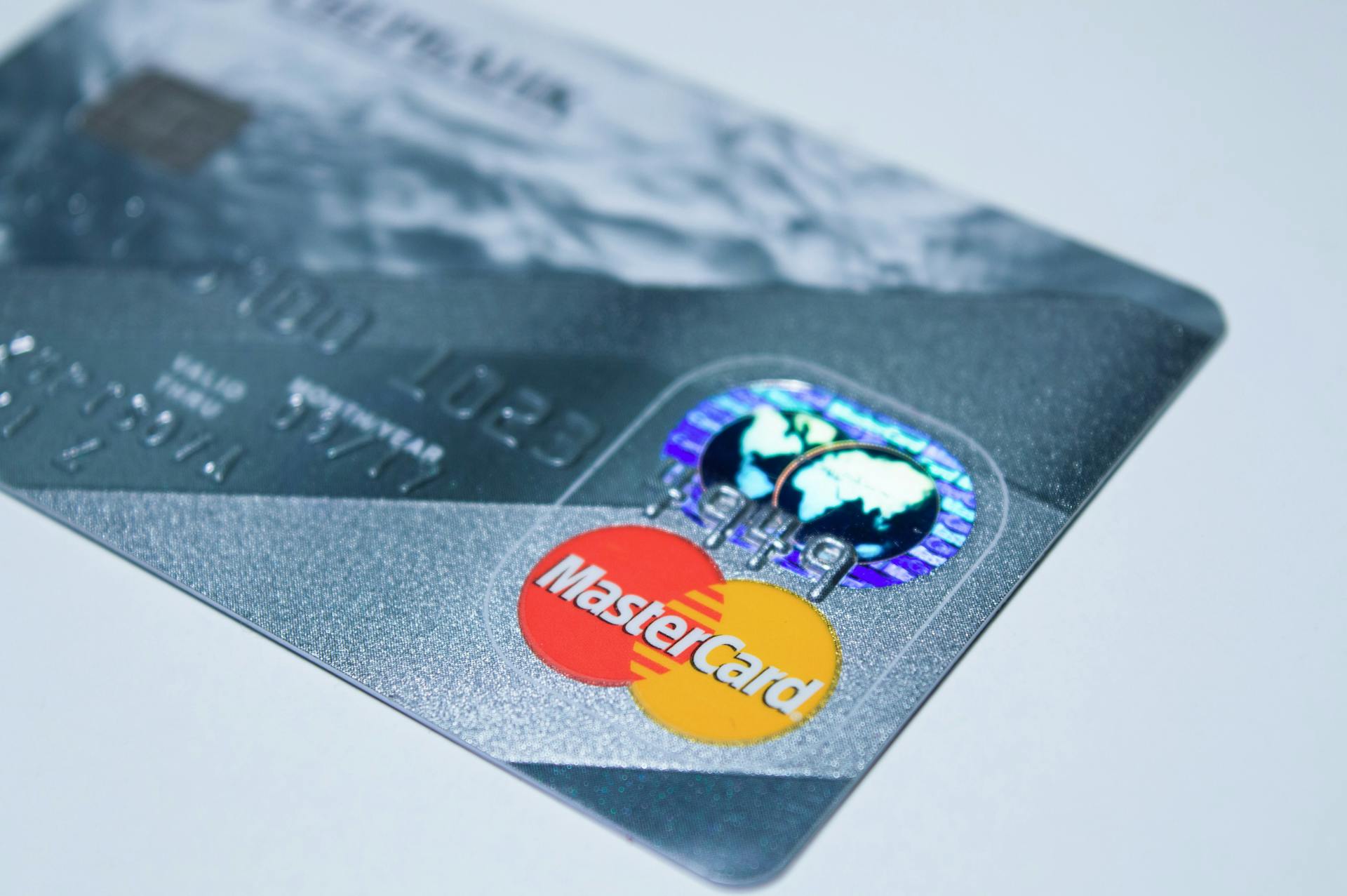
Girocard is a popular payment method in Germany, and for good reason. It's accepted at over 50 million acceptance points, including retailers, restaurants, and hotels.
You can use Girocard to pay for everyday expenses like groceries and public transportation. With over 90% of German retailers accepting Girocard, you can shop with confidence.
Girocard also offers a convenient and secure way to pay online, with many online merchants accepting Girocard payments.
For another approach, see: Daily Pay Cash Advance
What is Girocard?
The Girocard is a payment card that's been around since 2007, when it was introduced by the Zentralen Kreditausschuss (ZKA), now known as Die Deutsche Kreditwirtschaft, as a rebranding of the EC-Karte.
It's issued by German credit institutions, usually in conjunction with a Girokonto, or current account.
You can use your Girocard for contactless payments at POS terminals by simply placing the card or a mobile phone on the terminal, or by inserting the card into the terminal.
A PIN is required for verification, but you can skip it for contactless payments under 50 euros.
Explore further: Girocard Alemania
Girocard Features
Girocard features are often displayed on account statements in a specific format. This includes the payment method, terminal ID, date and time, authorization code, and card number.
The payment method is usually indicated by "EC" or "ELV", followed by the terminal ID, which is a unique identifier for the payment terminal. For example, the terminal ID might be "68197325".
The authorization code is a two-digit code that indicates how the payment was authorized. There are several types of authorization codes, including ME/MK, CE/CK, FE/2E, and IC/OC.
Here's a breakdown of the different authorization codes:
Authorization Feature
The Authorization Feature is a crucial part of Girocard transactions. It's a two-digit code that appears on your account statement.
This code indicates the method used to authorize the payment. You might see a combination of letters and numbers, like ME0 or IC0.
Let's break down the possible Authorization Feature codes:
- ME/MK: magnetstreifenbasierte Autorisierung (magnetic stripe-based authorization) for Girocard with Debitkarte (Debit card) or other cards
- CE/CK: chipbasierte Autorisierung (chip-based authorization) for Girocard with Debitkarte or other cards
- FE/2E: Spur 2 (Track 2) Fallback (FE:) and no Fallback (2E:)
- IC/OC: EMV Autorisierung (EMV authorization) for Offline (IC:) or Online (OC:) transactions
Zahlverfahren
Girocard offers a payment guarantee, which is not the case with ELV payments. This means that Girocard transactions are less likely to fail, making it a more reliable option for merchants.
In 2018, Girocard had a market share of 48.6%, which is a significant increase from 2009 when it was 19.4%. This shows how popular Girocard has become in recent years.
The electronic wallet GeldKarte can also be used for payments, but it has a very low market share of under 0.04% with a turnover of 0.1 billion EUR. This is likely due to the fact that many banks have stopped offering this service.
ELV, on the other hand, has been around since 1984 and was widely used in 2005, when it accounted for 12% of total sales. However, its market share has been declining in recent years.
Here's a comparison of the market shares of different payment methods:
Note that ELV's market share is not available for 2018, but it's clear that Girocard has become the dominant payment method in recent years.
Features Demystified
Each bank has a slightly different format for the design of a girocard.
Most girocards have a unique set of features, including the bank's logo, the cardholder's name, and the card number.
The design of a girocard can vary, but it typically includes the bank's name and the card's expiration date.
A Sparkasse girocard, for example, might have a specific layout that includes the bank's logo and the cardholder's name in a particular font.
Recommended read: Bmo Virtual Debit Card
Girocard Hardware and Software
A Girocard terminal is made up of both hardware and software components. The hardware components include a security module, keypad, screen, chip card reader, communication module, and power supply.
The software components consist of the operating system, communication software, security module software, and various additional software modules for online personalization of terminals, contactless payments, and additional applications.
To operate a Girocard terminal, you need to have a contract with a network provider. The technical network provider handles the processing of the data collected by the terminal, while a service provider takes care of the commercial aspects, offering support, technical assistance, and warranty services to the business owner.
A Girocard terminal has a unique terminal identification number (TID), which is assigned by the provider. Here is a list of some providers and their assigned TID number ranges:
- Adyen (507)
- BP Europe (710)
- Computop Paygate (508)
- Concardis (655)
- DB Vertrieb (590)
- Elavon (565)
- FirstData (540)
- Lavego (525)
- OC Payments (560)
- Payone (600,650,670,680)
- Shell (700)
- transact (695)
- Verifone (612)
- VÖB-ZVD (582)
- VR Payment (580)
- WEAT (740)
Pos
In Germany, the girocard network is widely used for point-of-sale payments, with over 770,000 locations accepting girocard payments in 2016, that's one location per 106 inhabitants.
The two main processing methods for girocard payments are chip-and-pin guaranteed girocard payment and chip-and-signature non-guaranteed Electronic Direct Debit (ELV).
One of the benefits of chip-and-pin guaranteed girocard payment is that it allows for a faster payment process, as it doesn't require an online connection.
However, not all banks offer this offline capability, and it's currently only available to a few banks.
Girocards are not equipped for e-commerce, and attempting to use the internal 19-digit card number through Maestro or V Pay will fail.
In contrast, SEPA Direct Debit transactions can be used for online payments, but they're often mislabeled as EC or girocard e-commerce transactions.
You can find a location that accepts girocard payments by checking the list of participating businesses in your area.
Here's a rough breakdown of the number of locations accepting girocard payments in Germany over the years:
Hardware and Software
Girocard Hardware and Software are two essential components that work together to facilitate electronic payments. The hardware part of a Girocard terminal includes the security module, keypad, display screen, chip card reader, communication module, and power supply.
The security module is a crucial component that ensures the integrity and security of transactions. The keypad allows users to input their PIN codes, while the display screen shows the transaction details. The chip card reader is responsible for reading the chip card information.
The software part of a Girocard terminal is equally important and consists of the operating system, communication software, security module software, and various additional software modules. These software modules include Online Personalization of Terminals (OPT), Contact EMV, and prepaid systems.
Here's a list of the main hardware components of a Girocard terminal:
- Sicherheitsmodul (Security Module)
- Tastenfeld (Keypad)
- Bildschirm (Display Screen)
- Chipkartenleser (Chip Card Reader)
- Kommunikationsmodul (Communication Module)
- Energieversorgung (Power Supply)
The terminal identification number (TID) is a unique identifier assigned to each terminal. Providers have assigned number ranges for their terminals, which start with specific numbers. Here are some examples of provider numbers:
- Adyen (507)
- BP Europe (710)
- Computop Paygate (508)
- Concardis (655)
- DB Vertrieb (590)
- Elavon (565)
- FirstData (540)
- Lavego (525)
- OC Payments (560)
- Payone (600,650,670,680)
- Shell (700)
- transact (695)
- Verifone (612)
- VÖB-ZVD (582)
- VR Payment (580)
- WEAT (740)
Magnetstreifen
The Magnetstreifen, a feature that was once a standard on Girocards, has undergone significant changes over the years.
Since 2000, many German banks have started issuing cards with an EMV Chip, which replaced the traditional Magnetstreifen in 70% of new cards by 2008.
Until 2011, the Magnetstreifen was still used for the Electronic Cash Verfahren, but the Bundeskriminalamt has since recommended that banks issue cards without Magnetstreifen as standard.
The Magnetstreifen on a card has three Spuren, but only Spur 2 is used for payments internationally.
As of 2013, Girocard Zahlungen over the Magnetstreifen are no longer allowed, except for the CoBadge.
The EMV Chip has become the primary means of authorization, making it impossible to copy the chip's contents.
A different take: Money Center Bank
The Logo
You can identify a Girocard with the Girocard logo on the debit card.
The Card Number
The Card Number is a crucial component of Girocard transactions. It's a 16-digit number, typically embossed on the card's magnetic stripe or stored in its chip.
This number is used to identify the account holder and route transactions through the Girocard network. The card number is usually preceded by a country code, indicating the card's origin.
The first digit of the card number is the Major Industry Identifier (MII), which is a one-digit code assigned to the card's issuing organization. The remaining 15 digits are the Personal Account Number (PAN), which identifies the account holder's account.
The card number is used in conjunction with the Expiration Date to authenticate transactions and verify the card's validity.
Discover more: Free Online Checking Account with Virtual Debit Card
Frequently Asked Questions
Can I use girocard outside Germany?
Girocards are primarily used in Germany, but you can use them abroad with international payment systems like Maestro or V-Pay. Check with your bank before traveling to see if your girocard will be accepted in your destination country.
What is the difference between a credit card and a Giro card?
A Girocard transaction goes directly to your bank account, whereas a credit card transaction involves a third-party service that takes a percentage of the transaction. This key difference affects how your money is handled and what fees you may incur.
Can I use girocard for Apple Pay?
No, Apple Pay does not directly support girocard payments, but you can use it with merchants that accept girocard as an alternative payment method.
Sources
- https://de.wikipedia.org/wiki/Girocard
- https://en.wikipedia.org/wiki/Girocard
- https://banks-germany.com/information/bank-cards/what-is-a-girocard/
- https://www.commerzbank.de/group/newsroom/press-releases/applepay-girocard.html
- https://ga.de/ga-english/news/debit-card-instead-of-giro-card-what-consumers-need-to-know-now_aid-76940549
Featured Images: pexels.com


